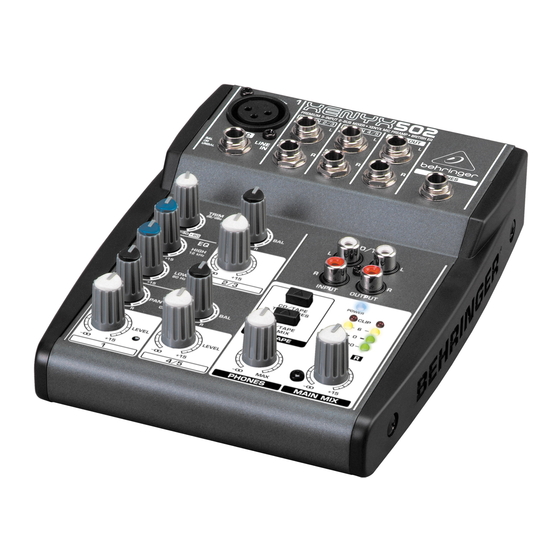
Table of Contents
Advertisement
Quick Links
PODCAST QUICK-START GUIDE
Welcome to the BEHRINGER PODCAST quick-start guide
Thank you for choosing one of our podcast-capable products. This top-notch
bundle of hardware and software lets you creatively produce professional sounding
podcasts for the Internet. Move up to the next step in the evolution of broadcast-
ing, and free yourself and others from the limitations of conventional mass com-
munication.
Podcasting Basics
Before you get started, it is important to understand some of the terminology and
uses surrounding the emerging field of podcasting.
Podcasting is a term derived from the combination of the words "iPod" and "broad-
casting, " and is defined as the distribution of audio or video files, such as radio
programs or music clips, over the Internet. This is accomplished by using one of two
syndication techniques that allow users to access media on such portable media
devices as the iPod and laptop computers.
RSS (Really Simple Syndication) and Atom are Web content syndication formats
written in XML that provide either podcast content or summaries that link to con-
tent and additional file information.
Podcast is a feed of audio or video files placed on the Internet for public access.
Anyone can subscribe to the feed and download the media files. This allows you to
collect programs from a wide range of sources for listening or viewing media con-
tent, either online or offline with your computer or an appropriate portable device.
Podcatcher refers to a software application that enables the download of podcasts.
It typically runs in the background, managing feeds that you add manually and
downloads each at a specified interval.
Version 1.0
Advertisement
Table of Contents

Summary of Contents for Behringer PODCASTUDIO
- Page 1 PODCAST QUICK-START GUIDE Welcome to the BEHRINGER PODCAST quick-start guide Thank you for choosing one of our podcast-capable products. This top-notch bundle of hardware and software lets you creatively produce professional sounding podcasts for the Internet. Move up to the next step in the evolution of broadcast- ing, and free yourself and others from the limitations of conventional mass com- munication.
- Page 2 PODCAST QUICK-START GUIDE Installation Guide – USB or FireWire interface XM8500 HPM1000 Computer UCA222 XENYX502 Basic equipment: Computer, Software, USB or FireWire interface (internal or external), Mixer, Microphone, Headphones Now that you have a basic understanding of what podcasting is and have the nec- essary gear, it’s time to set up the equipment, install the software and get started.
-
Page 3: Audio Interface
If using a Windows operating system, it is important to install the necessary ASIO driver. This is not a factor on Mac systems. Install the included DAW recording programs, such as energyXT BEHRINGER edition, Ableton Live Lite 4 BEHRINGER edition, Audacity and Kristal Audio Engine. Version 1.0... - Page 4 PODCAST QUICK-START GUIDE Note – Audacity does not support ASIO. In your new DAW software, make sure to select your USB or FireWire device as the incoming audio source. The Audacity software is not capable of exporting your recorded podcast in MP3 format, which is the preferred format for use on the Internet.
- Page 5 All trademarks (except BEHRINGER, the BEHRINGER logo, JUST LISTEN and PODCASTUDIO) mentioned belong to their respective owners and are not affiliated with BEHRINGER. Mac, Mac OS and Firewire are trademarks of Apple Computer, Inc., registered in the U.S. and other countries.
- Page 6 (2) this device must accept any interference received, including interference that may cause undesired operation. Important information: Changes or modifi cations to the equipment not expressly approved by MUSIC Group can void the user’s authority to use the equipment. behringer.com...
















Need help?
Do you have a question about the PODCASTUDIO and is the answer not in the manual?
Questions and answers